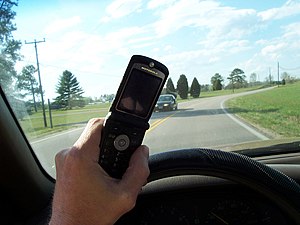Driver distraction is a major cause of accidents on our roads. More research into driver distraction is therefore welcome.
Traditional media available in vehicles, such as radios and entertainment systems, can affect visual attention, and the current use of GPS navigation assistance and personal communication devices have been repeatedly shown to interfere with the primary driving vigilance and motor control task. Such research has informed road authorities to restrict their use, particularly with regard to mobile phone use and texting for example.
The introduction of Intelligent Transport Systems has the potential to overload the driver if such systems are not tailored to driver workload according to location, traffic density and other ambient conditions. A more accurate and layered approach to driver workload and attention level can provide a structure upon which information can be conveyed appropriately and distractions reduced or minimised.

Hume Freeway looking south towards Victoria, running parallel to Albury railway station. (Photo credit: Wikipedia)
There are many instances however where use of communication devices in vehicles may actually help in vigilance (for example, long distance driving) and the ability to operate a mobile office whilst driving has undoubted productivity benefits. The problem is that the driving environment can potentially change in milliseconds and cause an overload of the driver’s available perceptual and attentional resources.
The aspect of appropriate speed limits in long distance driving could also be re-addressed. There has been a spate of single driver transport accidents on the Hume Freeway recently which have had tragic (and potentially disastrous consequences). Apart from driver fatigue and scheduling issues, is the posted speed limit too low to maintain sufficient driver arousal levels? Long boring drives at inappropriately low speeds could also encourage further distraction (such as use of mobile devices) perhaps even increasing the potential danger. This may not be ideal given that the severity of an incident at 100kph is still as catastrophic as one at 110 or 120kph. If speed kills, then surely it follows that the only safe speed is zero. There is a balance between the efficient movement of goods and the consequences of error. Does this mean that interstate transport needs to travel at 40kph so that any incidents that occur are relatively minor? Would this result in more incidents because drivers would be bored out of their minds whilst blowing out transport schedules? There needs to be an open discussion by professionals in the field as to assessment of all of the risks rather than the current thinking that slowing traffic is the only solution as seems to be the case at present. The posted speed relative to the road design and condition could be reducing driver arousal and performance level below the desired optimal range.
The Human Machine Interface (HMI) remains central to safe and effective vehicle operation as the information it provides will allow the driver to retain effective control of the vehicle and help influence or even determine their behaviour. Information flow to the driver must be intuitive, readily understood, timely, and be responsive to driver attentional and distraction state. Unfortunately, there are many who have very little understanding of this requirement. For example, presentation of the “bells and whistles” mentioned in this proposed level crossing warning system may actually distract a driver at the worst possible time and cause more problems than the technology is trying to solve. Human scientists understand the many facets that determine the best way of presenting information so that it is perceived, recognised and acted upon in an optimal manner. If the proponent of this system had engaged human factors expertise in the first place or heeded their advice he may not have made such ill-considered comments. Perhaps he may get some guidance as to the importance of listening to human factors professionals when he presents his data at the upcoming ITS conference in Vienna. It would be good to have some critical assessment by any human scientists attending this conference of any actual (rather than derived or contrived) interactions that occurred during the trials which were conducted of this system.
The area of human interaction with technology is very complex and simplistic approaches (such as further unrestrained visual or auditory “bells and whistles blaring”) will rarely be the best solution. All the more reason to design and test proposals from a human science standpoint, heed the results and incorporate them into any proposed system. Which underscores the importance of the many respected facilities that incorporate human science input as a keystone of their research in ITS applications, vehicle design and driver behaviour. Hopefully their research findings are weighted appropriately (ie. seen as valid and reliable) by the governing authorities as compared to those of the “bell and whistle” variety.
















